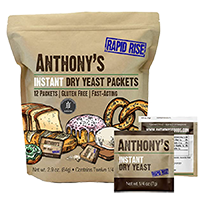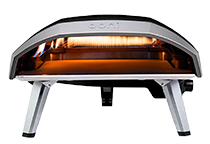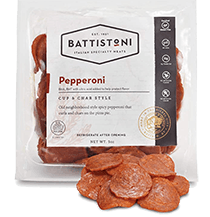Understanding how much yeast is in a packet of dry yeast is essential for both novice and experienced bakers. A common question that arises when following a bread recipe is how much yeast is needed. Most recipes call for yeast in either teaspoons or grams, and knowing how much is in a packet can help in accurately following the instructions.
A standard packet of dry yeast contains 2 1/4 teaspoons, which is equivalent to about 7 grams or 1/4 ounce. This amount is sufficient for a single loaf of bread or a recipe calling for a standard batch of dough.

The knowledge of how much yeast is in a packet also informs a baker about the proper storage and extends the yeast’s shelf life, ensuring it’s active and effective when used. Whether the yeast is active dry or instant, each type has its guidelines for optimal use in baking.
The effectiveness of yeast can be influenced by a variety of factors, such as temperature and moisture levels, so understanding how to correctly measure and store yeast is crucial for successful baking endeavors.
Key Takeaways
- A standard packet of dry yeast contains 2 1/4 teaspoons, about 7 grams or 1/4 ounce.
- Proper storage and knowing the shelf life of yeast contribute to its effectiveness.
- Correct yeast measurement and awareness of factors affecting its performance are key for baking success.
Table of Contents
Understanding Yeast and Its Forms
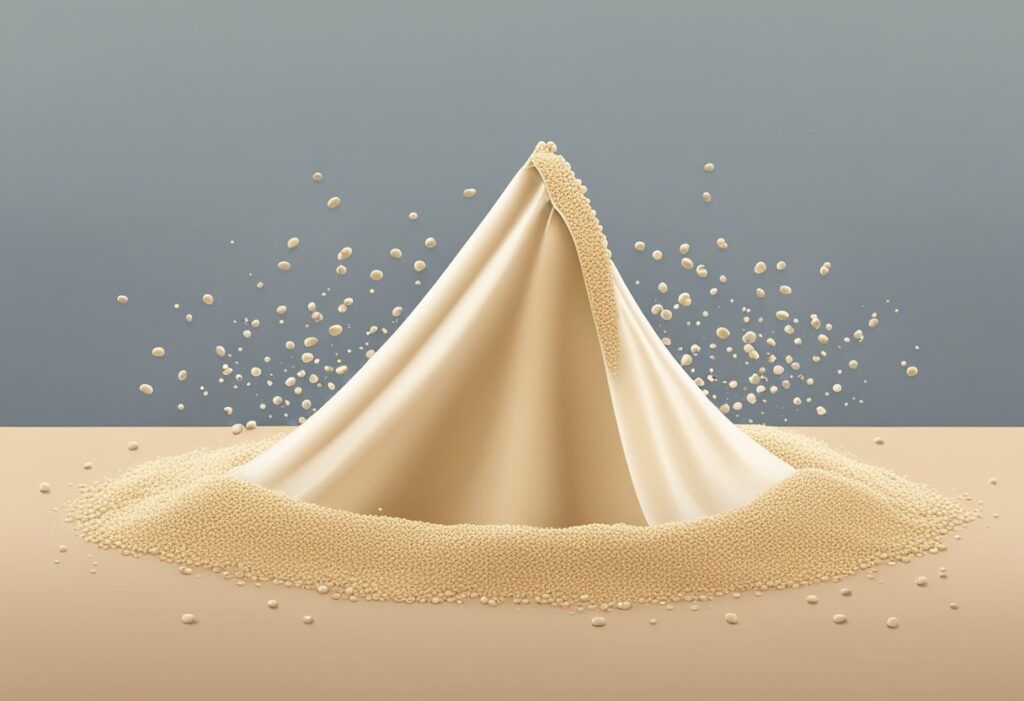
As a baker, I consider yeast to be a cornerstone ingredient in bread-making and I recognize it, simply, as a type of fungus known scientifically as Saccharomyces cerevisiae. This single-celled organism is responsible for fermentation, a process that allows dough to rise and develop flavor. Yeast comes in various forms, which can be quite different from one another in terms of usage and potency.
Active Dry Yeast
This is the most common type found in grocery stores. Created by removing most of the moisture from live yeast, it has a longer shelf-life and requires rehydration before use. Typically, I add it to warm water before mixing it into the dough.
| Form | Use Case | Rehydration Required? |
|---|---|---|
| Active Dry Yeast | General baking | Yes |
Instant Yeast
Also known as quick-rise or fast-acting yeast. This variety dissolves more quickly and does not always need to be proofed before being mixed into the dough. I find it more potent than its active dry counterpart, so less is needed for the same result.
| Form | Use Case | Potency |
|---|---|---|
| Instant Yeast | Quick baking recipes | Higher |
Fresh Yeast
Less common and more perishable, fresh yeast, also called cake yeast, can be used in recipes calling for active dry or instant yeast. It has a high moisture content and is often used by professional bakers for its reliable fermentation.
In my experience, while each type of yeast has distinct characteristics, they are interchangeable if adjusted for in the recipe. This adaptability allows bakers like me to use what they have on hand or prefer for a given baking task.
Standard Measurements for Yeast Packets

When working with yeast in baking, it’s important to understand the standard measurements that come with each packet. I’ll outline the typical contents found in these packets to help you with your baking projects.
Weight and Volume Equivalents:
A standard packet of dry yeast usually contains 7 grams. In terms of weight, this is about 1/4 ounce. Volume-wise, the amount is equivalent to 2 1/4 teaspoons. In my experience, this is a consistent standard across most brands, which makes it convenient when following recipes.
To give you a better visualization, here’s a table that correlates different measurements:
| Measurement | Equivalent |
|---|---|
| Grams | 7 grams |
| Ounces | 1/4 ounce |
| Teaspoons | 2 1/4 tsp |
Keep in mind that while weight is a more accurate measurement for yeast, many recipes will use volume for ease of use.
Note About Tablespoons: Although not directly equivalent to packet measurements, it’s handy to know that 3 teaspoons equal 1 tablespoon. This is a bit more than what’s in a yeast packet, as a packet is roughly equivalent to 3/4 of a tablespoon.
Using Yeast Packets: How much yeast is in a packet of dry yeast?
With each packet, 7 grams of yeast is generally sufficient to rise a dough made with up to 4 cups of flour. This consistent measurement across different yeast brands streamlines the process of adding the correct amount to your recipes, ensuring successful baking outcomes.
In summary, knowing these standard measurements allows for precise execution in recipes calling for a packet of yeast, whether the recipe specifies grams, ounces, or teaspoons.
Proper Storage and Shelf Life
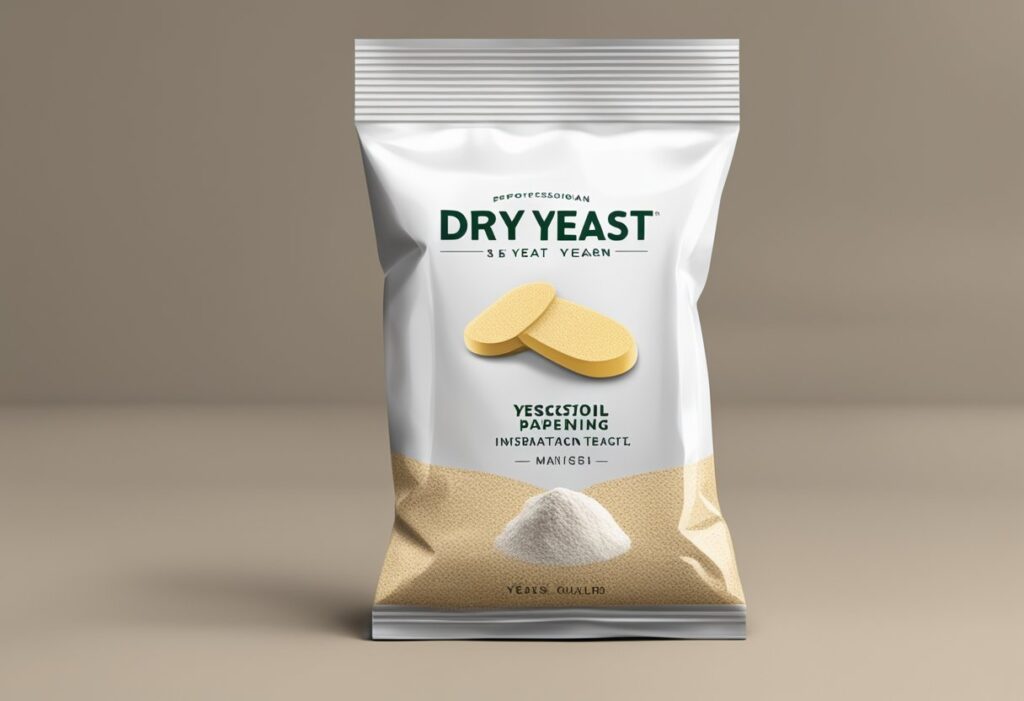
Storing yeast correctly is essential for maintaining its potency and ensuring that it performs well in baking. When I purchase yeast, it typically comes in small packets, each containing about 2 1/4 teaspoons, or 7 grams, which is the equivalent of one cake of compressed yeast. For long-term storage, I’ve found that unopened packets of dry yeast can be kept in the pantry until the printed expiration date. However, once opened, I ensure it stays fresh by following these guidelines:
- Refrigerator: In my fridge, opened dry yeast lasts for up to 4 months. I make sure to seal the original package inside an airtight container or a zip-top freezer bag to protect it from moisture and odors.
- Freezer: For an even longer shelf life, dry yeast can be stored in the freezer for about 6 months. Again, using an airtight container or a zip-top freezer bag prevents freezer burn and moisture from affecting the yeast’s viability.
The shelf life of yeast can vary depending on the storage conditions. I always check the yeast for activity before use by proofing it if there is any doubt about its efficacy.
| Storage Method | Unopened Shelf Life | Opened Shelf Life |
|---|---|---|
| Pantry | Until expiration | Not recommended |
| Refrigerator | Up to 5 years | Up to 4 months |
| Freezer | — | Up to 6 months |
I find maintaining a consistent, cool temperature and avoiding exposure to air and moisture are the keys to preserving the leavening power of yeast.
Using Yeast in Baking

In baking, yeast is a crucial ingredient that causes dough to rise by fermenting and creating carbon dioxide. Understanding the different types of yeast and their uses can profoundly affect the texture and outcome of your bread.
Activating Yeast in Dough
Active Dry Yeast: To activate it, I usually dissolve the yeast in warm water until it becomes foamy; this process is known as proofing. The water temperature should ideally be between 105°F and 110°F. It’s important because too hot can kill the yeast, and too cold may not activate it effectively. After about 5 to 10 minutes, the mixture should be bubbly, indicating that the yeast is alive and ready to work in the dough.
Instant Yeast: Unlike active dry, instant yeast doesn’t require proofing. I mix it directly into the dry ingredients, ensuring a faster process. Instant yeast has smaller granules and contains more live cells, hence its rapid action.
For any bread recipe, the standard measure in my kitchen is one packet of either type of yeast, which equates to approximately 2 1/4 teaspoons or 7 grams. Whether I’m making cinnamon rolls, pizza dough, or a classic loaf, this amount generally suffices for about 3 1/2 to 4 cups of flour.
It’s critical that I give the yeast enough time to produce gas, which means allowing the dough to rest during fermentation. This rest, or rise time, creates the desired bread texture, full of airy bubbles. Too little yeast can result in a denser bread, while too much might lead to an overpowering yeast flavor and excessive rise.
In general, my aim is to achieve a light, foamy texture before incorporating the yeast into my dough, monitoring temperature and measuring the quantities precisely to ensure optimal yeast performance.
Factors Affecting Yeast Performance
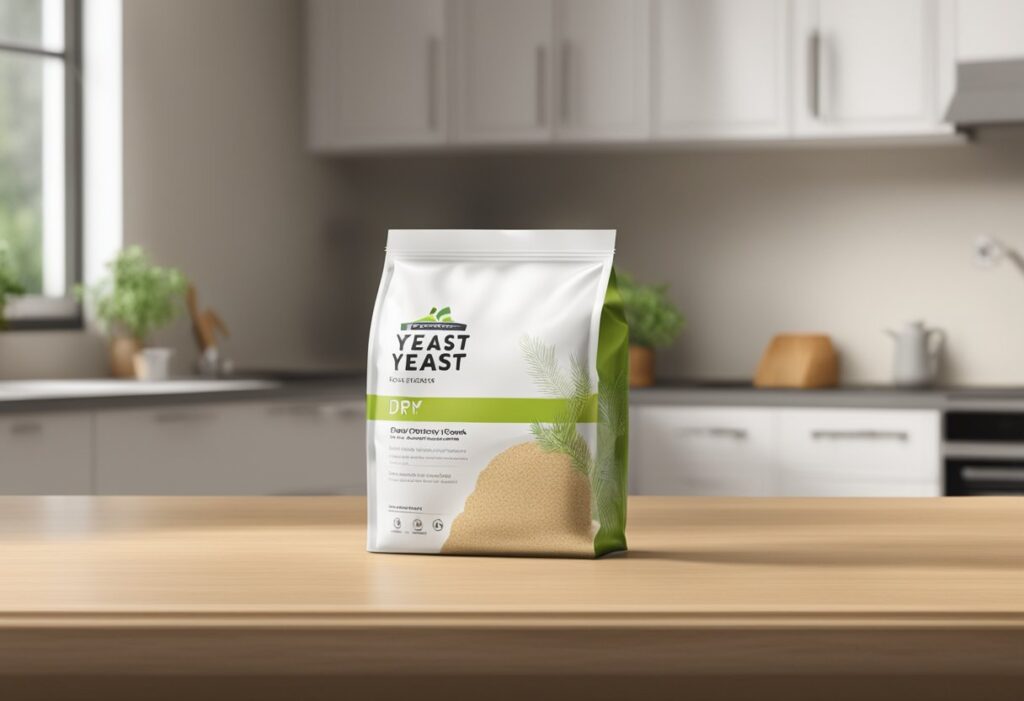
When I bake with dry yeast, several factors critically impact its performance. Yeast is a living organism, and like all living things, it requires certain conditions to thrive. I’ve outlined these conditions to help you achieve the best results in your baking endeavors.
Temperature: Yeast is most active at temperatures between 70°F and 100°F. If the water I add is too hot, it can kill the yeast, while if it’s too cool, the yeast may not activate well. My preferred strategy is to use warm water, around 110°F, which is slightly warmer than lukewarm, to ensure optimal activity.
Moisture: Yeast needs moisture to activate. I always dissolve the yeast in water as per the recipe’s instructions. This typically involves mixing the yeast with a small amount of water and sometimes with sugar to kickstart the process.
Sugar: A little sugar aids in yeast activation. I add about 1/2 teaspoon of sugar to the water and yeast mixture. This provides the yeast with a source of energy that helps it to “wake up” and begin the fermentation process.
Storage: Proper storage is key to maintaining yeast’s potency. I store my packets of dry yeast in a cool, dry place. If I’m not planning to use the yeast right away, I’ll refrigerate it to extend its shelf life.
Yeast Potency: Over time, yeast can lose its potency. I make sure to proof my yeast, especially if it’s been stored for a while. If I observe a good level of foamy froth after about 10 minutes, I can be sure that my yeast is active. Old yeast that doesn’t froth may result in poor fermentation and flat bread.
By considering these factors, I ensure that my dry yeast is effective and my baked goods rise properly.
Creative Uses and Advanced Tips
When I bake with yeast, particularly when using a packet of dry yeast, I often explore creative avenues to make my baked goods stand out. Here are some advanced tips I’ve picked up along the way, focusing on sourdough bread, sourdough starters, and even using a bread machine.
Sourdough Bread:
Sourdough bread is famed for its complex flavor, which can be partially attributed to wild yeast and lactobacilli present in the sourdough starter. However, for more consistent results, I introduce a portion of dry yeast from a packet. This can kick-start the fermentation process, especially when my kitchen is not at the ideal temperature for cultivating wild yeast.
Starting a Sourdough Starter:
- Day 1: Mix flour and water with a tiny pinch of dry yeast.
- Day 2 and beyond: Omit dry yeast and feed with equal parts flour and water.
For the Home Baker:
When you’re experimenting with new recipes or dabbling in bread-making for the first time, confidence comes from understanding the functionality of your ingredients. Remember, a standard packet holds about 2 1/4 teaspoons of yeast.
- Baking Projects: Use one packet to make a loaf of bread or multiple small buns.
- Substitutions: If a recipe calls for more yeast, simply open another packet.
Bread Machine Yeast:
If you have a bread machine, dry yeast from a packet is incredibly convenient. Create your own blend of flours and flavors, and rely on the bread machine yeast to do the heavy lifting during the fermentation process.
Table for Bread Machine Settings:
| Cycle | Yeast Amount | Additional Tips |
|---|---|---|
| Basic | 1 packet (2 1/4 tsp) | Perfect for white and mixed-flour bread. |
| Whole Wheat | 1 packet (2 1/4 tsp) | May require a bit more yeast for heavier flours. |
| French/Italian | 1 packet (2 1/4 tsp) | For crustier loaves. |
By incorporating these tips into your baking routine, you can enhance your skills and the quality of your baked goods, whether that’s a robust sourdough or a fluffy loaf from the bread machine.
Frequently Asked Questions
Understanding the quantity of yeast in a packet is crucial for your baking success. Each type of yeast has specific measurements and reacting behaviors that are important to be aware of.
How many teaspoons does one packet of active dry yeast contain?
One packet of active dry yeast typically contains about 2 1/4 teaspoons, which is enough to raise 4 cups of flour, making it sufficient for a standard bread recipe.
Can you quantify one packet of active dry yeast in tablespoons?
A packet of active dry yeast equates to approximately 3/4 of a tablespoon. This is a convenient measure when scaling recipes up or down.
What is the appropriate amount of water to use with one packet of yeast when baking?
Most recipes indicate that one packet of yeast should be dissolved in 1/4 cup of water. The water temperature should ideally be between 105° F and 110° F to properly activate the yeast.
What is the difference between active dry yeast and instant yeast in terms of usage?
Active dry yeast requires activation in warm water, whereas instant yeast can be mixed directly with dry ingredients without needing to dissolve it first. Both can be used interchangeably when adjusted properly, but instant yeast is a little more potent.
What are the steps to properly activate yeast for bread recipes?
To activate yeast, dissolve it in warm water (105°F-110°F) with a pinch of sugar. Let it sit for about 5-10 minutes until it becomes frothy. This indicates that the yeast is alive and ready to use in your recipe.
Is there a difference in measurement between a packet of Fleischmann’s yeast and other brands?
A standard packet of Fleischmann’s yeast contains the same amount as other brands, which is approximately 2 1/4 teaspoons or 1/4 ounce (7 grams). This standardization makes it easy to switch between brands in recipes.

